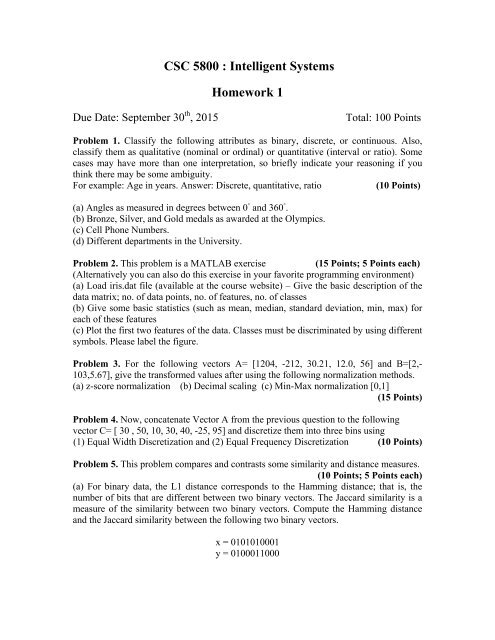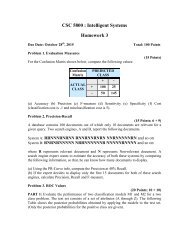CSC 5800 Intelligent Systems Homework 1
Homework 1
Homework 1
Create successful ePaper yourself
Turn your PDF publications into a flip-book with our unique Google optimized e-Paper software.
<strong>CSC</strong> <strong>5800</strong> : <strong>Intelligent</strong> <strong>Systems</strong><br />
<strong>Homework</strong> 1<br />
Due Date: September 30 th , 2015<br />
Total: 100 Points<br />
Problem 1. Classify the following attributes as binary, discrete, or continuous. Also,<br />
classify them as qualitative (nominal or ordinal) or quantitative (interval or ratio). Some<br />
cases may have more than one interpretation, so briefly indicate your reasoning if you<br />
think there may be some ambiguity.<br />
For example: Age in years. Answer: Discrete, quantitative, ratio<br />
(10 Points)<br />
(a) Angles as measured in degrees between 0 ◦ and 360 ◦ .<br />
(b) Bronze, Silver, and Gold medals as awarded at the Olympics.<br />
(c) Cell Phone Numbers.<br />
(d) Different departments in the University.<br />
Problem 2. This problem is a MATLAB exercise<br />
(15 Points; 5 Points each)<br />
(Alternatively you can also do this exercise in your favorite programming environment)<br />
(a) Load iris.dat file (available at the course website) – Give the basic description of the<br />
data matrix; no. of data points, no. of features, no. of classes<br />
(b) Give some basic statistics (such as mean, median, standard deviation, min, max) for<br />
each of these features<br />
(c) Plot the first two features of the data. Classes must be discriminated by using different<br />
symbols. Please label the figure.<br />
Problem 3. For the following vectors A= [1204, -212, 30.21, 12.0, 56] and B=[2,-<br />
103,5.67], give the transformed values after using the following normalization methods.<br />
(a) z-score normalization (b) Decimal scaling (c) Min-Max normalization [0,1]<br />
(15 Points)<br />
Problem 4. Now, concatenate Vector A from the previous question to the following<br />
vector C= [ 30 , 50, 10, 30, 40, -25, 95] and discretize them into three bins using<br />
(1) Equal Width Discretization and (2) Equal Frequency Discretization (10 Points)<br />
Problem 5. This problem compares and contrasts some similarity and distance measures.<br />
(10 Points; 5 Points each)<br />
(a) For binary data, the L1 distance corresponds to the Hamming distance; that is, the<br />
number of bits that are different between two binary vectors. The Jaccard similarity is a<br />
measure of the similarity between two binary vectors. Compute the Hamming distance<br />
and the Jaccard similarity between the following two binary vectors.<br />
x = 0101010001<br />
y = 0100011000
(b) Which approach (Jaccard or Hamming distance) is more similar to the Simple<br />
Matching Coefficient, and which approach is more similar to the cosine measure?<br />
Explain. (Note: The Hamming measure is a distance, while the other three measures are<br />
similarities, but don’t let this confuse you.)<br />
Problem 6. For the following vectors, x and y, calculate the indicated similarity or<br />
distance measures.<br />
(10 Points; 5 Points each)<br />
(a) x = (0,−1, 0, 1), y=(1, 0,−1, 0) cosine, correlation, Euclidean<br />
(b) x = (0, 1, 0, 1), y = (1, 0, 1, 0) cosine, correlation, Euclidean, Jaccard<br />
Problem 7. Mike completes jogging one round on a (circular) athletic track of radius 1<br />
mile. John is waiting for him at the center of the track. Compute the minimum and<br />
maximum possible values for the following distance measures between Mike and John<br />
while Mike is jogging: Manhattan, Euclidean and Chebyshev distance. (10 Points)<br />
Problem 8. Give the range (Lower bound and upper bound) for the following measures<br />
(assume n-dimensional space): (i) Euclidean Distance, (ii) Cosine Similarity (iii) Simple<br />
Matching Coefficient (iv) Hamming Distance<br />
(10 Points)<br />
Problem 9. Solve the following two problems<br />
(10 Points; 4 + 6 Points)<br />
(a) Two vectors x and y have zero mean. What is the relationship of the cosine measure<br />
and correlation between them?<br />
(b) Derive the mathematical relationship between cosine similarity and Euclidean<br />
distance when each data object vector has an L2 length (magnitude) of 1. (NOTE: your<br />
final answer should be independent of the original vectors).




